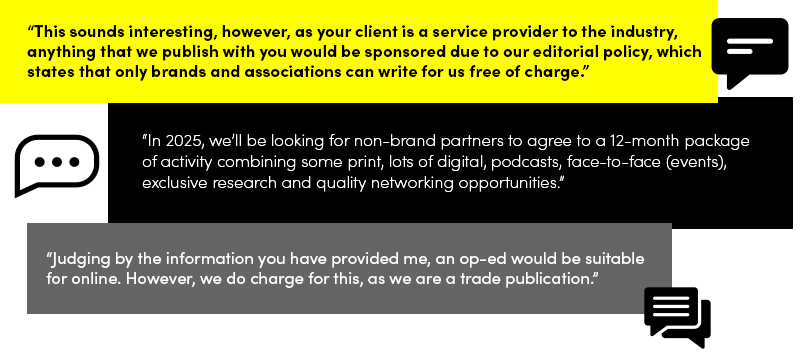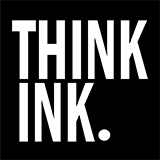Pitching to Ghosts: What the New and Weird World of Media Means for B2B
Jul 21, 2025 / By Jennifer Non
5 Min Read
The traditional media landscape changed
Check in on your journalist friends. They’ve been through hell in the last ten years.
Newsrooms gutted. Layoffs on repeat. “Fake news” attacks hurled by the President at anyone reporting inconvenient facts. And now, GenAI threatens to replace bylines with bots.
This is what the death spiral of traditional media looks like. Publications have been imploding for over a decade, squeezed by broken business models and eroding public trust. Things are getting weird, but that isn’t necessarily a bad thing. More on that in a bit.
What happens to your B2B PR strategy when the journalists leave?
Here’s the part most brands are still catching up on: the media collapse doesn’t just affect journalists. It affects you, the communications and marketing professionals who are trying to earn visibility for your clients’ businesses. Getting earned media feels ten times harder, and as the media landscape fractures, marketers are confronting the fact that their old playbook no longer works.
The reporters you’re pitching? Many of them are gone. Or they’re overworked, underpaid and burned out. Some started Substack newsletters, joined podcasts, or crossed over to the dark side and joined PR firms (welcome!).
In all seriousness, when was the last time you got hold of someone at a newsroom or caught up over a coffee? Don’t get me wrong, I’m not lamenting the old days; as PR professionals, we must continuously adapt. But the inability to develop media relationships or get hold of who we need, combined with savage competition for coverage, is both frustrating and chaotic.
What happens to your B2B PR strategy when publishing models change?
Meanwhile, the line between editorial and advertising has become blurrier than ever as publications fail to find viable business models. These are several responses we’ve received from aviation trade publications we’ve pitched in the past year:

Despite the industry upheaval, many traditional outlets haven’t offered much ingenuity in response. They haven’t really changed their formats, have fewer resources and may seem out of touch with certain audiences.
“Innovation in media has been relatively underwhelming,” said John Walton, a veteran aviation journalist and founder of The Up Front—a new, journalist-owned media venture focused on independent aviation reporting. “I have watched media outlets change hands or swap editors with no real vision. Most haven’t figured out how to use modern tech in meaningful ways.”
Because publishers have been so slow to adapt, they’re getting cannibalized by social media figures posing as reporters. Which is why you might one day find yourself dealing with an “influencer” with no journalistic background running some highly influential platform where you must pay to play and wondering, “What are we even doing anymore?”
These business model shifts, layoffs and closures aren’t likely to slow down, so let’s take a closer look at what it all means.
Your traditional B2B PR strategy is obsolete
When it comes to brand PR, “it’s always been easier for companies to engage with newspapers and trades. That’s how they’ve always done it,” according to Walton.
Walton’s right. We’ve seen it. Most brands still treat media the way they did in 2012: generic press releases, mass email blasts, spray-and-pray pitching striving for vanity visibility. But that approach is dead on arrival in today’s climate. PR professionals trying to "ticky-box" their way through a media strategy won't succeed. In Walton’s view, the biggest challenge to brands looking to engage with the media is "ossification and doing things how you’ve always done them."
So, here are some stats for your next communications team meeting when you need to make a case for change:

NOTE: As we were developing this article, we couldn’t find any recent B2B/trade media consumption statistics (which is very sad in itself), which prompted us to do our own B2B PR and Trade Media survey. Send us email to info@thinkinkpr.com if you would like to receive a copy of the findings when they’re available.
The rise of journalist-driven alternative media
But this story doesn’t end with a death; there’s somewhat of a renaissance happening right now. Journalists are building their own platforms: niche newsletters, Discord servers, hyper-targeted podcasts. Places where they can go deep, stay independent and rebuild trust with audiences who care. They’re getting creative and having fun with their craft. It’s actually kind of refreshing.
Vulture recently published a piece, Substack Is Where Writers Go to Be Weird, highlighting the rise of the newsletter platform, which is a growing refuge for journalists and writers. Substack facilitates direct-to-reader journalism where the creator can be in charge, without the red tape. High-profile reporters are even making the leap: Glenn Greenwald, co-founder of The Intercept, left his publication after editorial misalignment and launched Outside Voices on Substack. Brian Sumers, a former airline reporter for Skift, also moved to Substack and started The Airline Observer. It’s a great example of how journalists can build a niche (and dedicated) audience and retain their unique voice and integrity.
This journalist-driven movement also extends to trade news. Take The Up Front, for example. Walton helped launch it after spending nearly two decades in traditional aviation trade media. This platform is not trying to be The Wall Street Journal; it’s not even trying to replicate traditional trade models. It is long-form B2B+C content about aviation with strictly limited ads and a subscription model. It’s focused, insider-driven and built for people who care about the industry.
The publication’s power isn’t in the size of its audience—it’s in its niche relevance and joy of creation. And it certainly can’t be easily replaced by AI.
“The Up Front shows our passion: in our writing, in the real enjoyment that we take in our podcasts, and in fun stuff like Contact Decimal, which is our ambient music x air traffic control recordings podcast,” Walton said. “We make it for ourselves.”
And this is all good news for brands who are willing to try something new in their PR strategies.
In Walton’s words: “If your best customers are high-information consumers, you already have what they want. The job of expert media is to help translate that information with perspective and credibility. We know your customers. We talk to them—and to your competitors.”
>>Translation: Quality, credibility and a little creativity will go a long way.<<
What B2B PR strategy needs to look like now
If you're still pitching the way you did five years ago, you’re already invisible. We saw this coming, even before COVID. We called it out in our training, strategy decks and client workshops. And we’ve long advised that niche media is critical infrastructure, not second-tier scraps. We frequently tell clients that precision matters more than prestige, and we’ll aim for targeted visibility over vanity metrics any day. And, yes, pay-to-play is now part of the B2B public relations mix. We need to stop pretending it’s an exception and start building into earned media strategies from the outset.
Relationships, of course, matter, but without clear, compelling messaging refined for media audiences, even the strongest contact won’t save a weak pitch. With increasing volumes of AI-slop bombarding feeds, inboxes and screens, journalists need BS-free pitches and stories that resonate with their readers more than ever.
Traditional media won’t vanish overnight, but it’s no longer our trusty “go-to.” Publications fold. Business models change. The reporter you’ve built a rapport with over the years will be let go or start charging for inclusion. The B2B PR and media landscape has changed, and our B2B PR and communications strategies need to change with it.
Like a strong investment portfolio, diversification is important. Niche and alternative media may not draw millions of views, but they reach the right target audiences. Unlike sprawling legacy outlets, these platforms are sharply focused—and often more trusted—by the audiences that matter most to your business.
The bottom line: Adapt or disappear
This isn’t a one-size-fits-all media world. It’s a very splintered, fast-moving, often unpredictable media ecosystem. Pretending otherwise is a fast track to irrelevance. If your strategy still relies on outdated formulas, generic pitches or prestige placements with no real audience alignment, it’s time to recalibrate… if you haven’t been fired already.
B2B PR demands a different model today: one that accounts for fragmentation, prioritizes precision over volume and embraces change. The agencies and companies that adapt will find better channels, sharper stories and stronger outcomes. The ones that don’t? They’ll keep wondering why nothing’s landing.
Whether it’s redefining earned media, understanding the value of niche influence or building relevance in new and untested places, the traditional B2B PR playbook has changed.
Sign up for our insights on the convergence of business and PR








